Kings Island – Cincinnati, Ohio
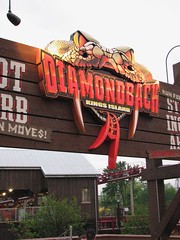 I’ll just say it straight out– I’ve never really understood the appeal of airtime. Extremely sharp ejector air that creates a sensation of unnerving danger and intensity, as found on Magnum or Phantom’s Revenge? Sure. Airtime used as a device over the length of an entire ride to add depth and complexity to the ride’s progression, as found on the Phoenix or Shivering Timbers? You betcha! But the sustained-for-as-long-as-possible, airtime-for-the-sake-of-airtime type of air? Vastly overrated, in my opinion.
I’ll just say it straight out– I’ve never really understood the appeal of airtime. Extremely sharp ejector air that creates a sensation of unnerving danger and intensity, as found on Magnum or Phantom’s Revenge? Sure. Airtime used as a device over the length of an entire ride to add depth and complexity to the ride’s progression, as found on the Phoenix or Shivering Timbers? You betcha! But the sustained-for-as-long-as-possible, airtime-for-the-sake-of-airtime type of air? Vastly overrated, in my opinion.
There, I’ve just admitted I’m an automaton with no soul. Now you have to read the rest of this review so you can try to decipher the secret code embedded in it that details my plans to take over the entire world in a very Michael Bay sort of way.
But seriously, why all the fanatical enthusiasm for simply experiencing a few seconds of weightlessness? Removed of any external context, to exist in a zero g-force environment seems just as banal and meaningless as a one g-force environment. I look at myself and think, “Great, now I’m in zero-g’s, what am I supposed to do with this?”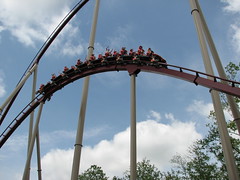 Obviously in some absolute, experiential way they are different effects, but so is a one decibel sound wave compared to silence. That doesn’t mean it‘s any closer to being a great piece of music; isolated all by itself it’s simply nothing, white noise. I have a similar relationship to g-forces.
Obviously in some absolute, experiential way they are different effects, but so is a one decibel sound wave compared to silence. That doesn’t mean it‘s any closer to being a great piece of music; isolated all by itself it’s simply nothing, white noise. I have a similar relationship to g-forces.
Before I alienate too many of my readers, I can perhaps relate to the sense of relief felt at having the normal forces constantly yanking on my bones and internal organs to be lifted for a brief moment and allow me to enjoy total freedom. I realize that is a crucial distinction that can only be achieved through pure, unfiltered weightlessness. Except for I still always have this huge freakin’ lapbar pinning me down in my seat, but most enthusiasts seem to try to forget it’s there the best they can.
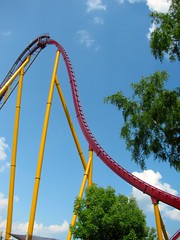 Having now established the philosophical perspective from which I will critique the new-for-2009 Diamondback, it should be all too easy to draw the conclusion that the ride is nothing more than a vacuous heap of shit, albeit precision-engineered, 22-million dollar shit. Not so fast. From my singular ride on Nitro last year, despite the fact that it too is not much more than an arbitrary collection perfectly parabolic hills and geometrically-consistent spirals plugged into each other, I was considerably impressed (somewhat to my own bewilderment; I’m still hoping that it was because I just was glad to get out out of that awful queue). I’d also love more than anything to return to Busch Gardens Europe to try Apollo’s Chariot again, as looking at the splendid use of terrain and small design quirks that set up certain moments, I could see placing that one in my top 10 steel if the mood strikes me right next time. And I wouldn’t dare argue that there is a better riding coach imaginable than B&M’s. Diamondback could easily surpass those two examples, combining the pure scale of Nitro with the terrain aspects of Apollo’s Chariot into one incredible package. I guess there’s only one way to find out…
Having now established the philosophical perspective from which I will critique the new-for-2009 Diamondback, it should be all too easy to draw the conclusion that the ride is nothing more than a vacuous heap of shit, albeit precision-engineered, 22-million dollar shit. Not so fast. From my singular ride on Nitro last year, despite the fact that it too is not much more than an arbitrary collection perfectly parabolic hills and geometrically-consistent spirals plugged into each other, I was considerably impressed (somewhat to my own bewilderment; I’m still hoping that it was because I just was glad to get out out of that awful queue). I’d also love more than anything to return to Busch Gardens Europe to try Apollo’s Chariot again, as looking at the splendid use of terrain and small design quirks that set up certain moments, I could see placing that one in my top 10 steel if the mood strikes me right next time. And I wouldn’t dare argue that there is a better riding coach imaginable than B&M’s. Diamondback could easily surpass those two examples, combining the pure scale of Nitro with the terrain aspects of Apollo’s Chariot into one incredible package. I guess there’s only one way to find out…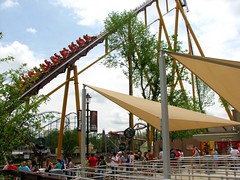
We’re in the front row on our first ride of the season, climbing the lift hill. Unlike Son of Beast, which playfully teases us with several dips and turns before committing to the first drop, Diamondback is not interested in such theatrics and is committed to transporting us to the apex of the first drop as quickly and efficiently as possible.
Speaking of efficacy, I cannot let it go unnoted that the wait for Diamondback that morning was less than 15 minutes long, and what small line they did have moved. It might be four seats fewer than its older speed coaster brethren, but while waiting in line Diamondback might as well have 15-car trains based on how quickly they shipped trains out of that station and loaded new guests in. On most B&M coasters a midcourse block-brake is more of a formality, but on Diamondback they use it, one train dropping off the lift before the other has even made it to the final brakes, and they keep this pace up the entire day. The one drawback is that Queue Nazis are frequently present, ordering us into whatever goddamn row they feel like and if we’ve got a problem with their selection we can go suck a lemon. Great if you’re looking to book as many rides as possible in a day, but if you’re more particular with where on the train you plant your keister like I generally am, well… Thankfully on our first ride a second attendant had to step in briefly while the Nazi on duty was off momentarily to re-arrange some derelicts that ignored orders, and that attendant was kind enough to grant us a front row request.
On most B&M coasters a midcourse block-brake is more of a formality, but on Diamondback they use it, one train dropping off the lift before the other has even made it to the final brakes, and they keep this pace up the entire day. The one drawback is that Queue Nazis are frequently present, ordering us into whatever goddamn row they feel like and if we’ve got a problem with their selection we can go suck a lemon. Great if you’re looking to book as many rides as possible in a day, but if you’re more particular with where on the train you plant your keister like I generally am, well… Thankfully on our first ride a second attendant had to step in briefly while the Nazi on duty was off momentarily to re-arrange some derelicts that ignored orders, and that attendant was kind enough to grant us a front row request.
On a second visit to the park in August I discovered that the single rider queue is another extremely useful feature, getting me onto the ride on an average of less than ten minutes, provided several teenage groups didn’t decide to use it instead of the regular line (ahem, guys, it says “single riders only”, why do I need to wait for all ten of you to fill valuable empty spots?).
I was quite concerned at first that the V-style seating represented a further step in isolating and alienating the riders from each other, placing a focus the individual’s own self-absorbed riding experience, rather than a collective one to be joyously shared with friends and strangers alike. Innumerable times while at the modern theme park I secretly think to myself, “I would be so much better off if these people around me didn’t exist”, and this type of seating arrangement could be seen as a concession (and reinforcement) to that mindset rather than subverting it altogether in a way the Phoenix does.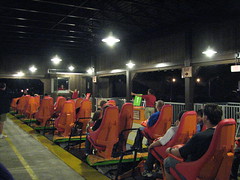
It actually works great, the non-intrusive restraints keep it easy to be aware and converse with the people next to you (as on a standard B&M speed coaster setup), but also across the train diagonally, the open-air V-pattern allowing visual communication with people up to three rows ahead of you. At the same time, this design allows more personal space to enjoy the ride on one’s own terms, and to clearly view the elements and surrounding scenery without having a huge headrest just a few feet in front of you. The seats and restraints are the most comfortable imaginable without sacrificing any safety or loading efficiency. Tipped back, lifting feet off the floor, a clamshell pillow restraint that does not understand the meaning of the word ‘staple’ even if you try…
The train crests the first drop. I find myself quite underwhelmed by this initial plunge. The only seats that do anything for me are the front, where I can hang for a few seconds looking straight down the drop, and towards the back, where there’s a bit of airtime. Even in this case, it’s really only the slight lift out of my seat that makes this element anything interesting, and any sensations of falling or extreme steepness seem somewhat muted. When I first saw the video of the ride I thought this looked like one of B&M’s best first drop profiles, with a long pull-over that reaches maximum steepness very close to the ground, before pulling out hard with very little transitional track. That is still kind of true, but the long pull-over reduces the forward angular rotation normally associated with steep first drops, and the resulting sensation is one that kind of keeps on going down until you hit the bottom, with not much else to it other than that. The pullout is somewhat strong, probably the highest positive g section on the ride (which isn’t saying much) but again I’m just somewhat disappointed by the speed and power to be found here.
The coaster’s statistics officially list maximum height: 230’, but then it lists length of first hill: 222’, and length of first drop: 215’, so I’m not positive what all that’s really suppose to mean. Regardless, when Kings Island announced the ride in 230 ft. range, I thought of a design that found a comfortable median between the scales of Magnum and Millennium Force. The truth is with a 215’ drop, the scale, speed and power seem to better approximate any one of the “basic 200 ft. hyper coasters”, rather than the “deluxe hyper coasters” that clearly go beyond the simple 200 ft. mark; after all, 215’ is within jumping distance of rides like Magnum or Raging Bull.
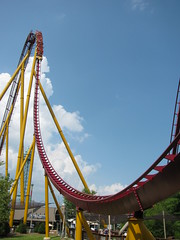 After the drop we surge up to crest the first hill. Seeing as the ride is not much more than a series of perfectly parabolic hills strung together with the intention of each providing the longest sustained airtime with however much speed it has, I might as well spend a bit of time analyzing exactly what kind of air this is. Although I clearly do not purport to be an airtime aficionado, I’m frequently surprised to find how many enthusiasts out there are unaware that there are more than two flavors of air. ‘Floater’ and ‘ejector’ air only describes the strength of the upward lift directly on the passenger; floater hangs around 0 g’s, while ejector probably describes g-forces in the range lower than -0.3. Diamondback was mostly floater, although I was surprised to find some borderline sustained ejector over at least the first two hills (that at least quelled one of my worries that the ride would pace too slow as B&M coasters are wont to do). What are the other qualities to this air?
After the drop we surge up to crest the first hill. Seeing as the ride is not much more than a series of perfectly parabolic hills strung together with the intention of each providing the longest sustained airtime with however much speed it has, I might as well spend a bit of time analyzing exactly what kind of air this is. Although I clearly do not purport to be an airtime aficionado, I’m frequently surprised to find how many enthusiasts out there are unaware that there are more than two flavors of air. ‘Floater’ and ‘ejector’ air only describes the strength of the upward lift directly on the passenger; floater hangs around 0 g’s, while ejector probably describes g-forces in the range lower than -0.3. Diamondback was mostly floater, although I was surprised to find some borderline sustained ejector over at least the first two hills (that at least quelled one of my worries that the ride would pace too slow as B&M coasters are wont to do). What are the other qualities to this air?
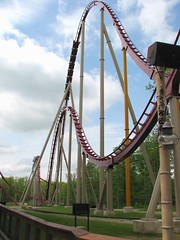 Ignoring the direct uplift forces the rider experiences, look at the shaping of the hill to help determine just what kind of airtime you’re in for. Diamondback’s hills are pointed, the radius tightening exponentially as it approaches the top. This tells me the train will be approaching zero miles per hour near the tops of the hill, and that B&M designed these hills to get the most vertical difference out of them as well, opposed to a ride with lower airtime hills and more consistently fast speed. It’s a myth that all camelback hills that feature perfectly sustained airtime have that distinct parabolic curve you probably learned about in high school physics class. Intamin is a classic counter-example of this. Observe their airtime hills and you’ll note two things. One; they appear much more circular in shaping than B&M’s (look no further than El Toro, or perhaps Millennium Force if you want an example in floater air), and two; they have a much higher rate of speed over the top. Because the relative change in speed is much less when the train begins the crest of a hill at, say 60mph and slows to 40mph at the zenith (compared to B&M where you might be going less than 20mph at the top), this means that the radius must be much more consistent in order to produce even g-forces.
Ignoring the direct uplift forces the rider experiences, look at the shaping of the hill to help determine just what kind of airtime you’re in for. Diamondback’s hills are pointed, the radius tightening exponentially as it approaches the top. This tells me the train will be approaching zero miles per hour near the tops of the hill, and that B&M designed these hills to get the most vertical difference out of them as well, opposed to a ride with lower airtime hills and more consistently fast speed. It’s a myth that all camelback hills that feature perfectly sustained airtime have that distinct parabolic curve you probably learned about in high school physics class. Intamin is a classic counter-example of this. Observe their airtime hills and you’ll note two things. One; they appear much more circular in shaping than B&M’s (look no further than El Toro, or perhaps Millennium Force if you want an example in floater air), and two; they have a much higher rate of speed over the top. Because the relative change in speed is much less when the train begins the crest of a hill at, say 60mph and slows to 40mph at the zenith (compared to B&M where you might be going less than 20mph at the top), this means that the radius must be much more consistent in order to produce even g-forces.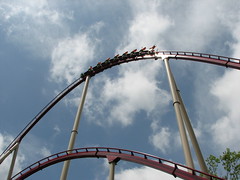
So what? It’s perfect floater in either case, what does this analysis mean for me when I’m riding Diamondback?
It means that you go up much higher and have much steeper drops on the camelback hills. It means that the speed is much more uneven, creating a greater distinction between the wind in your face at the bottoms and the slow sailing over the tops. It also plays with your inner-ear much more. Although physically you may be pulled at -0.2 g’s over the entire length of the hill, careful attention to your inner ear can create a very different experience from the flatter, faster variety of airtime hill. Cresting the top at a tight radius and lower speeds more quickly changes your 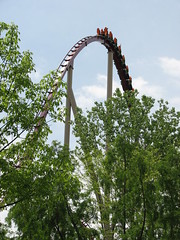 orientation to earth (resulting in greater forward rotational forces), and when you’re falling back down, because the angle is steeper, the uplift is along the forward z-axis rather than the usual upward y-axis, created more by the fact that we’re accelerating while facing straight down rather than from centrifugal forces exerted outwards by the curvature of the hill.
orientation to earth (resulting in greater forward rotational forces), and when you’re falling back down, because the angle is steeper, the uplift is along the forward z-axis rather than the usual upward y-axis, created more by the fact that we’re accelerating while facing straight down rather than from centrifugal forces exerted outwards by the curvature of the hill.
Hey, this ride almost sounds interesting! And it should get even more interesting since on the decent of this second hill is when the terrain starts to come into play. The drop reaches down 193 feet into one of the park’s ravines, which is also where that maximum speed of 80 miles per hour is achieved. Does this sound familiar? It appears as though Kings Island was trying to put this big, graceful Beemer on a similar level creatively with Phantom’s Revenge, and with an entire layout extending out into the same wooded landscape that the Beast occupies. Just from writing that I want to put this coaster on my top ten list. Diamondback is positively brimming with potential to be one of the few truly great modern steel coasters.
So why is it when we’re pulling out of this second drop, I’m still feeling incredibly underwhelmed? Did we even just drop down a natural ravine? Funny, I never would have guessed.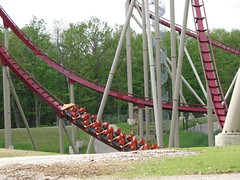
Yes, it would seem that when Cedar Fair and B&M get together, there is no limit to how incredibly mediocre they can make an otherwise great concept. When rumors were first gathering about Diamondback there seemed to be no limit to the possibilities. I think a 260 ft. third drop down a 100 ft. ravine was originally part of the ride’s rumored equation, and B&M have at least proved themselves capable at making a large-scale ride well integrated with the natural surroundings once in a blue moon with coasters like Apollo’s Chariot or (almost) Wildfire. That might have been hoping for a little too much under even the best of circumstances, but still, imagine how amazing it would be, riding a coaster with the power and grace of a B&M speed coaster through the same rugged, natural landscape that made the Beast famous. Keep on imagining because that coaster was never even close to being built.
natural landscape that made the Beast famous. Keep on imagining because that coaster was never even close to being built.
The ‘ravine’ has been completely clear-cut within 20 yards of the track, graded into a shallow dip in the terrain that allows the coaster maybe ten feet of extra dropping space, and paved over with a system of blacktop maintenance roads wide enough for two-lane traffic. Without looking at the land from the Crypt exit, I’d barely be able to tell there was any uneven terrain at all, and the tracking is so smooth and consistently designed the few extra MPH are used to achieve precisely jack-squat. Instead of trees and tangled brush rushing past along the ground-level stretches of track, there’s chain-link fence and gravel, although Kings Island was so kind enough to plant neatly manicured grass over the acres of cleared woodland the ride runs along that’s not occupied by concrete or gravel. If you don’t strain your neck too hard to notice the thick line of trees on the horizon one could probably be duped into feeling as though they’re on a parking lot coaster. With the Crypt and a large open field on the left side, it doesn’t even feel like you start to approach the woods until the dive after the second camelback hill into the far turn around. I never was expecting a ride from B&M and Cedar Fair to really have too much regard for the terrain surrounding it, but what’s there is essentially my worst-case scenario for how this coaster could have used the land, and neither B&M nor Kings Island seem to care.
was so kind enough to plant neatly manicured grass over the acres of cleared woodland the ride runs along that’s not occupied by concrete or gravel. If you don’t strain your neck too hard to notice the thick line of trees on the horizon one could probably be duped into feeling as though they’re on a parking lot coaster. With the Crypt and a large open field on the left side, it doesn’t even feel like you start to approach the woods until the dive after the second camelback hill into the far turn around. I never was expecting a ride from B&M and Cedar Fair to really have too much regard for the terrain surrounding it, but what’s there is essentially my worst-case scenario for how this coaster could have used the land, and neither B&M nor Kings Island seem to care.
 While it might be better than sitting in the bleak void of empty space with no points of reference whatsoever, saying that having the tree line cut back 15 yards further is just a minor disappointment is a big understatement. On Diamondback the tree line becomes a uniform wall in the background, while on a ride like the Beast, the trees seem close enough in areas that a fundamental perception about the woods is changed; it becomes a major element of the ride, altering the sense of spatial relations and putting the eye and brain on sensory overload as it tries to process the complex and ever-changing texture to the surroundings. I’d be curious to see if any official research has been done on the subject but I think a ‘magic distance’ the tree line must be within in order to distinguish between the two vastly different experiences of traveling through the trees verses traveling past the trees. It seems like there should be, as I imagine it’s the effect of parallax that creates these different sensations, and with trees planted within a few feet of each other in most woods, I’d estimate that it’s a fairly precise dividing line,
While it might be better than sitting in the bleak void of empty space with no points of reference whatsoever, saying that having the tree line cut back 15 yards further is just a minor disappointment is a big understatement. On Diamondback the tree line becomes a uniform wall in the background, while on a ride like the Beast, the trees seem close enough in areas that a fundamental perception about the woods is changed; it becomes a major element of the ride, altering the sense of spatial relations and putting the eye and brain on sensory overload as it tries to process the complex and ever-changing texture to the surroundings. I’d be curious to see if any official research has been done on the subject but I think a ‘magic distance’ the tree line must be within in order to distinguish between the two vastly different experiences of traveling through the trees verses traveling past the trees. It seems like there should be, as I imagine it’s the effect of parallax that creates these different sensations, and with trees planted within a few feet of each other in most woods, I’d estimate that it’s a fairly precise dividing line,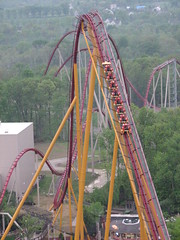 one that Diamondback falls way outside of.
one that Diamondback falls way outside of.
I’ve now spent nearly a full page on Microsoft Word bitching about wasted use of landscape which probably only myself really cares about, so I’ll get back to dissecting the layout. It’s quite standard for a B&M Speed Coaster, with pretty much nothing to analyze from a pacing, timing or progression point of view. I appreciate that the way out has two full camelback hills instead of just one, since one of my beefs with the generic Speed Coaster design is they only have one full hill before the turnaround, making the ride feel very short. Maybe I’m just too accustomed to Shivering Timbers, but by my own criteria a coaster doesn’t qualify as an out-and-back until there has been more than one hill before the turnaround, preferably three. So while Diamondback isn’t quite all there, it’s better than Behemoth or Apollo’s Chariot (at least in that regard), and I imagine the balance of two straight, airtime laden hills work better as an opening act than either Nitro or Silver Star’s one-curved-one-straight hill approach.
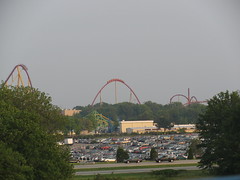 The coaster’s smoothness is commendable, but not exquisite. It seems no matter when and where I rode Diamondback, the front always offered a smoother ride than the back row, which featured some shaking on the higher-speed pullouts. I almost preferred this when I visited in May, since the ride is so controlled that at times it can be difficult to tell that you’re even moving faster than 55. Later in August, however, the entire trains had picked up some bad trembling. Diamondback was still far and away the smoothest coaster in the park, but on those other rides, a bit of roughness is to be expected, that’s simply part of the riding experience, without it they become boring. Since B&M’s track work places so much emphasis on mathematical precision, the slightest vibration can detract from the style of ride they’re going for. I think it was just a case of the wheels started to get some minor deformities after more than a half-season of use,
The coaster’s smoothness is commendable, but not exquisite. It seems no matter when and where I rode Diamondback, the front always offered a smoother ride than the back row, which featured some shaking on the higher-speed pullouts. I almost preferred this when I visited in May, since the ride is so controlled that at times it can be difficult to tell that you’re even moving faster than 55. Later in August, however, the entire trains had picked up some bad trembling. Diamondback was still far and away the smoothest coaster in the park, but on those other rides, a bit of roughness is to be expected, that’s simply part of the riding experience, without it they become boring. Since B&M’s track work places so much emphasis on mathematical precision, the slightest vibration can detract from the style of ride they’re going for. I think it was just a case of the wheels started to get some minor deformities after more than a half-season of use,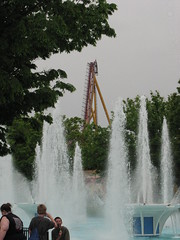 perhaps they were parked on the track in the same position for too long, causing the contact point with the track to flatten a little bit (this is partly why the storage shed parks the trains on a series of rollers resting on their undercarriage).
perhaps they were parked on the track in the same position for too long, causing the contact point with the track to flatten a little bit (this is partly why the storage shed parks the trains on a series of rollers resting on their undercarriage).
Does seating make a difference to the sort of air experienced? The front might surprise some by really launching them out of their seat as they begin to crest, but this momentum isn’t long sustained before they end up hanging forward into the front of their restraints on the way down. I prefer the back overall, because the hill builds in intensity very consistently over the entire crest, from remaining firm in one’s seat at the start of the crest, mild floater at the crest, and then semi-strong ejector all the way down to the pullout. One of my more interesting rides in terms of quality of airtime was when I was placed in the mathematical center of the train; the precision engineering of the hills was incredibly present, and at the same time I wondered why B&M spend so much time fine-tuning their geometry when the long trains they use horribly distort their effects anywhere outside of a few seats near the middle.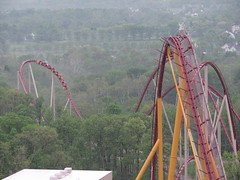
We now arrive at the turnaround, which should be rather awesome, banked well past the ninety-degree mark, but it somehow comes up a bit flat. Maybe it’s all contained in too singular of a movement, sweeping up, around and back down without any change in dynamics throughout the entire maneuver. The positive g-forces remain incredibly even and unforceful, and there’s only the slightest hint of rotational motion as the train swoops around the top in one fluid motion.
From here it charges up into the third camelback hill, but not before passing over the rides first trim brake on the way up. In May it let us through without a hitch, in August we got grabbed a little.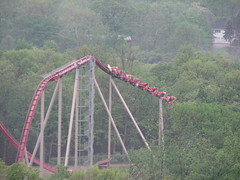 It doesn’t matter too much because the midcourse is just past the next curve anyway, but especially when the trim is on it makes this third camelback feel a lot like a throwaway element. It’s designed and profiled to produce the exact same dynamics as the first two, only it’s not as tall or as fast, so it really can only pale in comparison to what was just experienced without bringing anything new to the table… except for being situated underneath the second camelback. On the one hand, that introduces some light headchopper effects, on the other, it only highlights how much smaller this element is than the previous one. This third camelback also acts as the stand-alone element that separates the two turnarounds, so from a layout viewpoint it doesn’t contribute anything to the rest of the ride, other than to exist on its own for a solitary moment of air.
It doesn’t matter too much because the midcourse is just past the next curve anyway, but especially when the trim is on it makes this third camelback feel a lot like a throwaway element. It’s designed and profiled to produce the exact same dynamics as the first two, only it’s not as tall or as fast, so it really can only pale in comparison to what was just experienced without bringing anything new to the table… except for being situated underneath the second camelback. On the one hand, that introduces some light headchopper effects, on the other, it only highlights how much smaller this element is than the previous one. This third camelback also acts as the stand-alone element that separates the two turnarounds, so from a layout viewpoint it doesn’t contribute anything to the rest of the ride, other than to exist on its own for a solitary moment of air.
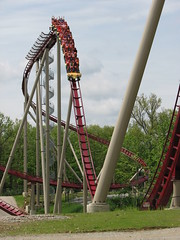 Now we have the spiral into the midcourse brake run. Hmm, for a ride that’s focused on airtime it’s rather hard to get more than two moments before it has to waste time and track on some sort of turn. Nitro uses a midcourse spiral in a similar fashion, but to much greater effect. That spiral stands as a high g-force extended centerpiece to the ride, whereas Diamondback’s is just there to get us up to the midcourse brake. It does not stand as a centerpiece, taking about the same time to complete as every other element along the first part of the course, and produces next to no g-forces or dynamics contrast. If the middle camelback was a throwaway element, this one’s turning the return course into a veritable garbage dump, although thankfully this trend is not completely continued to the end of the coaster.
Now we have the spiral into the midcourse brake run. Hmm, for a ride that’s focused on airtime it’s rather hard to get more than two moments before it has to waste time and track on some sort of turn. Nitro uses a midcourse spiral in a similar fashion, but to much greater effect. That spiral stands as a high g-force extended centerpiece to the ride, whereas Diamondback’s is just there to get us up to the midcourse brake. It does not stand as a centerpiece, taking about the same time to complete as every other element along the first part of the course, and produces next to no g-forces or dynamics contrast. If the middle camelback was a throwaway element, this one’s turning the return course into a veritable garbage dump, although thankfully this trend is not completely continued to the end of the coaster.
The midcourse also grabs a little, but we crest the drop with more speed than I think Behemoth has at this point in the ride, and the long straight drop down into the ravine jumpstarts the pace into forward momentum again after a lackluster denouement from the spiral and brake run,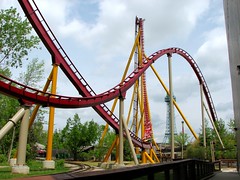 even providing a strong kick of air if you’re in the back.
even providing a strong kick of air if you’re in the back.
We pull up into the first of the two returning air hills. I have mixed feelings about these, and their placement after the ravine drop off the midcourse brake. They pull up really short (the train tracks run under one and the Crypt entrance beneath the other, so rather than adjust the design B&M had them pull up twenty feet above the ground to simply build over these landmarks) and they feel disappointingly small in comparison to the large ravine drop that seemed to promise us more for a finale. However, being so much smaller they do provide a slightly different feel. More rounded in overall profiling, they provide a tighter “up, around and over” forward rotational motion that distinguishes them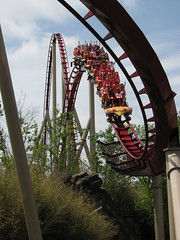 from the large camelback hills in the first part of the ride, and the timing between elements is picking up a little here through use of the raised pull ups, although it’s still all pretty slow. If I’m really desperate to find more to analyze about these hill’s meaning in the overall context of the coaster, I could say they also mirror the two large camelback hills that opened the ride before things got disjointed with the hammerhead turn, camelback and upward spiral that all only exist for layout requirements.
from the large camelback hills in the first part of the ride, and the timing between elements is picking up a little here through use of the raised pull ups, although it’s still all pretty slow. If I’m really desperate to find more to analyze about these hill’s meaning in the overall context of the coaster, I could say they also mirror the two large camelback hills that opened the ride before things got disjointed with the hammerhead turn, camelback and upward spiral that all only exist for layout requirements.
Speaking of things that only exist for layout requirements, we now have a second upward spiral. After riding this twenty times I still can find no reason for this maneuver to exist on its own, it really does nothing for the rider. Although closing one’s eyes during the ride can always produce an experience approaching a highway drive, it’s this element in particular that comes closest to actually feeling like I’m napping in the car. Hold your arms straight out and you can faintly feel a force pulling them downward, otherwise nothing. It’s not just the forcelessness that’s a problem, but all of these spirals and turnarounds completely break flow from what 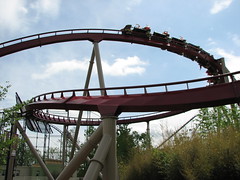 should be an airtime-centric coaster. Looking at the overhead drawing of the layout that was first leaked many months ago these semi-helices made sense (it needs to turn another 73 degrees to the left to get it to line up with the station, why not throw in a 287 degree right helix instead?) but from a rider’s perspective these are pointless distractions.
should be an airtime-centric coaster. Looking at the overhead drawing of the layout that was first leaked many months ago these semi-helices made sense (it needs to turn another 73 degrees to the left to get it to line up with the station, why not throw in a 287 degree right helix instead?) but from a rider’s perspective these are pointless distractions.
Thankfully this one serves a bit more purpose than the previous spiral which only acts as an anticlimactic entry into the brake run, while this one at least sets up the final dive into the pond. I actually think this pond dive works rather well despite being a flat stretch of track that would seem to end the coaster with a moment that’s there more for the onlookers than the riders. Sit in the very back row and you can catch a lot of water that shoots up mere inches behind you in scarily impressive quantities. Also, after spending an entire ride with 20 foot clearances on all sides it’s nice to end the coaster with a moment that finally gives some immediacy to the surroundings (if the seats weren’t raised so high I feel I could easily skim the toe of my shoe along the water’s surface).
that shoots up mere inches behind you in scarily impressive quantities. Also, after spending an entire ride with 20 foot clearances on all sides it’s nice to end the coaster with a moment that finally gives some immediacy to the surroundings (if the seats weren’t raised so high I feel I could easily skim the toe of my shoe along the water’s surface).
However, like other aspects of Diamondback, this pond dive probably worked better as an abstract, Platonic ideal when it was on the drawing boards and featured in the preview animations; the actual execution of this feature is probably the most disappointing of all the possible Diamondback pond dives that could exist in alternate realities, save for the one in which it’s filled with acid rain and/or leeches. A shallow, clearly  artificial concrete basin is set in the middle of a cleared grassy field, a huge buffer between the splashdown and any viewable midway. If the splashdown is not going to be an interactive centerpiece like it is on SheiKra and Griffon, why is it also made to look so cheap and unnatural from a distance? I know it’s a cliché but landscaping in Cedar Fair’s vocabulary seems to be limited to four words: grass, gravel, woodchips and shrubs. To their credit they don’t leave exposed concrete around like the old Six Flags regime was notorious for, but criminy their grounds are starting to look like cheapo suburban homeowner’s lawn projects. I strongly suspect that landscaping is never a topic discussed amongst the managers when budgets are approved, and that a modest but workable budget is simply afforded yearly to the park’s landscaping departments,
artificial concrete basin is set in the middle of a cleared grassy field, a huge buffer between the splashdown and any viewable midway. If the splashdown is not going to be an interactive centerpiece like it is on SheiKra and Griffon, why is it also made to look so cheap and unnatural from a distance? I know it’s a cliché but landscaping in Cedar Fair’s vocabulary seems to be limited to four words: grass, gravel, woodchips and shrubs. To their credit they don’t leave exposed concrete around like the old Six Flags regime was notorious for, but criminy their grounds are starting to look like cheapo suburban homeowner’s lawn projects. I strongly suspect that landscaping is never a topic discussed amongst the managers when budgets are approved, and that a modest but workable budget is simply afforded yearly to the park’s landscaping departments, to which the landscapers are then left to only their own devices to decide how to keep the areas around new rides as well as the parks in general in presentable form, with little to no authority to do anything beyond that. I also suspect that this is why the terrain around Diamondback’s out leg suffered so badly, as it wasn’t in Adena Corp’s interests to preserve any trees or hillsides around the site besides the minor ravine dive that was part of B&M’s specifications, and after construction was over the landscapers did what little they could so it wouldn’t be running over flat dirt. In some ways I almost think leaving the land around the ride as open dirt fields might be more beneficial in the long run. The back of Michigan’s Adventure was a similar sandy field for many years, but recently the area has been reclaimed by the native flora and it’s quite
to which the landscapers are then left to only their own devices to decide how to keep the areas around new rides as well as the parks in general in presentable form, with little to no authority to do anything beyond that. I also suspect that this is why the terrain around Diamondback’s out leg suffered so badly, as it wasn’t in Adena Corp’s interests to preserve any trees or hillsides around the site besides the minor ravine dive that was part of B&M’s specifications, and after construction was over the landscapers did what little they could so it wouldn’t be running over flat dirt. In some ways I almost think leaving the land around the ride as open dirt fields might be more beneficial in the long run. The back of Michigan’s Adventure was a similar sandy field for many years, but recently the area has been reclaimed by the native flora and it’s quite a beautiful backdrop to the rides now, with many species of Michigan wildflowers and tall grass filling in the areas not occupied by growing trees. I think the area around Diamondback could easily have the same look if only the park didn’t try so hard making it look manicured and, well, boring.
a beautiful backdrop to the rides now, with many species of Michigan wildflowers and tall grass filling in the areas not occupied by growing trees. I think the area around Diamondback could easily have the same look if only the park didn’t try so hard making it look manicured and, well, boring.
This criticism extends to the station, queue and entire “new” Rivertown as well. I’ve heard some early reporters claim that the area looks great, which having visited in person I’m convinced they are mistakenly confusing with the term “new”. Yes, the area all looks very “new” and “polished”, but nothing about it suggests that it will look like anything other than a second-rate funfair once a few years have gone by and the endless rows of the same wooden fences and boxy queue lines haphazardly planted over grassy fields start showing a bit of age. The station house in particular is a true let-down, clearly trying to impersonate similar rustic houses from rides like the Beast and Maverick, but without any constraints requiring creative solutions, the architecture is as bland and solely functional as it could be imagined, the only hint that this is even supposed to be an  old west setting is the wood paneling deliberately cut at uneven angles (I’m positive if still alive today, many settlers of the western expansion would take exception to the atrociously bad carpentry skills theme parks always seem to credit them for, especially when the wooden boards that are haphazardly nailed in at hilariously skewed angles have clearly been cut and treated by a modern sawmill).
old west setting is the wood paneling deliberately cut at uneven angles (I’m positive if still alive today, many settlers of the western expansion would take exception to the atrociously bad carpentry skills theme parks always seem to credit them for, especially when the wooden boards that are haphazardly nailed in at hilariously skewed angles have clearly been cut and treated by a modern sawmill).
And that reminds me of another point that’s irked me ever since the ride was announced—hello, Rivertown isn’t themed to the old west! I suppose that’s what we can expect when executives are only thinking in the broadest established genres in the industry, but for a themed area iconic for dense temperate forests and riverside lumberyards, I’m not sure where they got the idea that a desert reptile would be “fitting in”. I still suppose it’s a step in the right direction after the previous management thought Tomb Raider and the Italian Job were perfect franchise tie-ins to fit the area. The only creative touch on Diamondback I can slightly commend is the look of the zero-car on the trains. The snake head design that even includes fangs on the underside makes Diamondback one of the few modern coasters where the trains strongly identify which coaster they belong to without the use of a single stick-on logo. With that I think I’ve finally run out of notes in my mental notebook I wanted to comment on so I move on to the summary of what all the pages of content above were leading to:
where they got the idea that a desert reptile would be “fitting in”. I still suppose it’s a step in the right direction after the previous management thought Tomb Raider and the Italian Job were perfect franchise tie-ins to fit the area. The only creative touch on Diamondback I can slightly commend is the look of the zero-car on the trains. The snake head design that even includes fangs on the underside makes Diamondback one of the few modern coasters where the trains strongly identify which coaster they belong to without the use of a single stick-on logo. With that I think I’ve finally run out of notes in my mental notebook I wanted to comment on so I move on to the summary of what all the pages of content above were leading to:
–
Diamondback is by no stretch of the imagination a bad ride (indeed I found there was no place else I’d rather be on a Sunday afternoon when the single rider queue promised re-rides in less than ten minutes), but the finished product is as underwhelming as $22 million dollars worth of B&M terrain speed coaster could conceivably be. It’s the output of a system where the only inputs come from business people and engineers, each mostly concerned with their own sets of numbers, and whose few creative responsibilities to the attraction manifest themselves in predictable, high-concept ideas, such as utilizing a swan pond for a splashdown finale or making some use of the terrain… and even these concepts fail to reach their full potential since after they are envisioned there’s nothing in the system to check that they aren’t perverted from their ideal during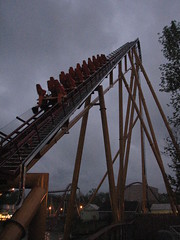 the construction process. The layout is clearly designed for whatever fits best on the blueprints rather than what the riders should be experiencing at any given moment. Even if it’s only there to provide as much uninterrupted airtime as possible (an approach I personally would disapprove of, although I might praise the level of focus devoted to a singular task), Diamondback may disappoint since true camelback hills are spaced few and far between pointless curving maneuvers that are there just because they are, with only two ‘really good’ moments provided before the coaster shows signs of slowing down, and of course being a B&M project they do little to compensate for the loss of speed. Closing one’s eyes reveals an experience that chooses, without regard to any other subtleties, to oscillate as evenly as possible between 2 g’s and 0, except for when it randomly goes from 2 g’s to the 1.5 in a turn instead. That is not a great coaster experience! While it can’t be said that it doesn’t do what it’s supposed to do perfectly, any time businesspeople and engineers throw $22 million at a project with only a vague notion of what it is they should be accomplishing with it, that’s sort of the least we can expect.
the construction process. The layout is clearly designed for whatever fits best on the blueprints rather than what the riders should be experiencing at any given moment. Even if it’s only there to provide as much uninterrupted airtime as possible (an approach I personally would disapprove of, although I might praise the level of focus devoted to a singular task), Diamondback may disappoint since true camelback hills are spaced few and far between pointless curving maneuvers that are there just because they are, with only two ‘really good’ moments provided before the coaster shows signs of slowing down, and of course being a B&M project they do little to compensate for the loss of speed. Closing one’s eyes reveals an experience that chooses, without regard to any other subtleties, to oscillate as evenly as possible between 2 g’s and 0, except for when it randomly goes from 2 g’s to the 1.5 in a turn instead. That is not a great coaster experience! While it can’t be said that it doesn’t do what it’s supposed to do perfectly, any time businesspeople and engineers throw $22 million at a project with only a vague notion of what it is they should be accomplishing with it, that’s sort of the least we can expect.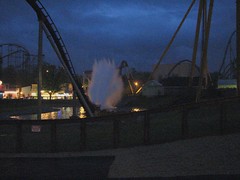
Alright, so since I’m such the brainiac what might I have done differently to make a better ride experience? I would have started by asking “what is this coaster really about”, and then pouring as much emphasis into those qualities as possible. Ideally, smooth speeds, airtime and use of the natural geography. Just behind where the far hammerhead turnaround resides, there is a huge drop-off into a valley that probably totals well over 100 feet in height difference. The only genuine excuse I can think of that the park might have not taken advantage of this fantastic landscaping is there are some power lines that run along this valley that maybe Kings Island couldn’t get permission to build near (maybe they don’t even own the land beyond that turnaround,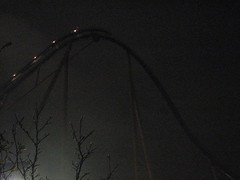 although given how far back the Beast goes I’d be surprised to hear that’s the case). Using all of that, here’s the alternative Diamondback layout I’d propose:
although given how far back the Beast goes I’d be surprised to hear that’s the case). Using all of that, here’s the alternative Diamondback layout I’d propose:
Start the station farther back inside the park so the start of the lift spans the Rivertown midway, not the first drop. I know it’s less dramatic for onlookers but I need a way to let the layout extend farther back into the wood without simply making it longer, besides I would argue that the present configuration is perhaps too attention-grabbing, plus doing so save more space inside the park for potential future additions. Have the first drop extend down into that original ravine, so that a much more impressive 235 foot plunge with 80+mph speeds can be achieved on the first drop, which can also be made steeper. Build the second camelback more or less as it presently is, finishing about where the pullout into the hammerhead turn is; this second drop will naturally be much shorter than the first not having a ravine, giving the illusion that the ride is losing momentum. Now, up the second tall camelback hill (remember, B&M’s shaping allows these hills to maximize heights while maintaining 0 g’s) and into the third drop: use that gigantic valley, and let that train keep falling until the drop passes at least the 240 foot mark and speeds go into and beyond the “holy shit!” range, especially when trees are whizzing by at close proximity. From here the coaster would transform into a manic ground level flight through the woods, a turnaround at the bottom of the drop sending us back toward the general direction the station is located without us really knowing it, having lost our orientation in the thick forest in much the same way as the Beast. Some quick and unpredictable direction changes hidden by the trees aside, because we’ve been taken farther out than the actual version of Diamondback the returning run would be much more lean and straight-shot, eliminating the two spirals to save track. After that fast and furious (and unforgettably unique, and top ten worthy) sprint through the woods, the ride would suddenly regain altitude as it must climb back up the ravine, the midcourse brake run positioned here. A straight series of at least three classic airtime hills to wrap up the ride with (not just two) might lead to a pond splashdown that’s instead located on the outside perimeter of the back midway, dragging plenty of mist along to spectators, rising up from the pond over the midway into the brakes. This design not only makes use of nearly the same lift height and track length specifications of the original, while saving a bit on steel supports by reducing the number of tall hills (should please the construction people), but also will put it in the Guinness Top Ten list of fastest coasters and longest drops (should please the marketing people), and also featuring a far better, more original layout that not only features more speed and extended weightlessness (should please the enthusiast people), but dramatic progression and dynamics shifts along the arc of the ride experience (should please pretentious, over-analytical assholes like me).
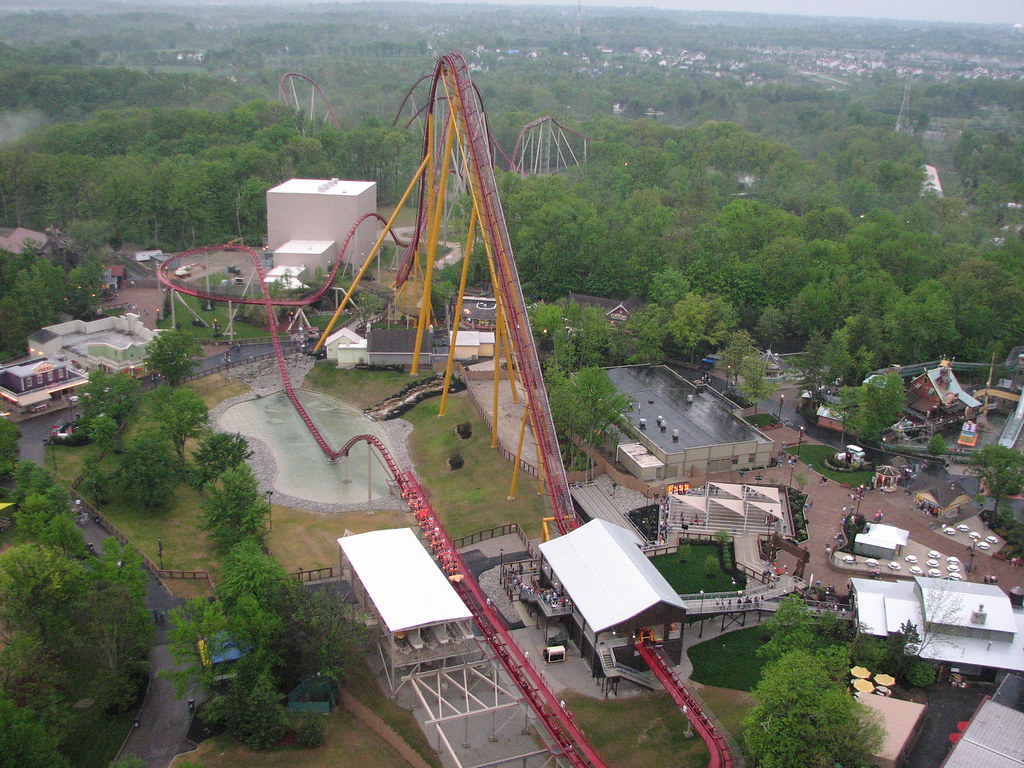
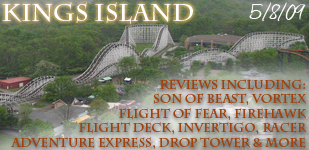
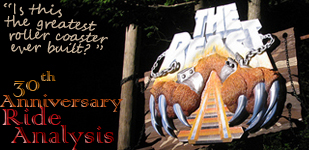
I tried describing my ideal version of Diamondback given the same resources in the last paragraph of the essay, so I guess that’s there for you to judge.
This is the most ridiculous review I have ever read. I can’t believe someone spent so much time typing out such drivel.
Try medication.
Yes! It took almost 9 years, but this website finally got the hard trolling it’s always deserved!
How does this B&M Hyper hold up, from a no-limits 2 creator Projektion, atleast from general appearance.:
https://www.youtube.com/watch?v=omSwiUBSmxs&t=277s
Also, what many of the enthusiasts call the best of B&M’s hyper collection, seems to have failed miserably in your criteria, pity.
But, I see your very strong reviewing point.
I’ve probably mellowed on Diamondback somewhat since it first opened. It’s smooth, reliable, re-ridable, high capacity, and still pretty fun. At the time that it opened there was the expectation that a major new terrain B&M hyper should easily be one of the top ten steel coasters of all time, and while some might reasonably rate it as such, I never experienced the euphoria of a design that defies all comparable benchmarks with Diamondback. In fact since Banshee opened, I’d say I’ve easily found a new favorite B&M in the park, a ride that continues to surprise me even after multiple re-rides.
Well, Hallelujah, though it is FAR from the best B&M Hyper(Raging Bull, Apollo’s Chariot, Nitro)
Pardon, I mean in your opinion, since well, I have not a single Hyper-coaster credit(Due to my unfortunate location and lack of ability to travel due to father’s funds)